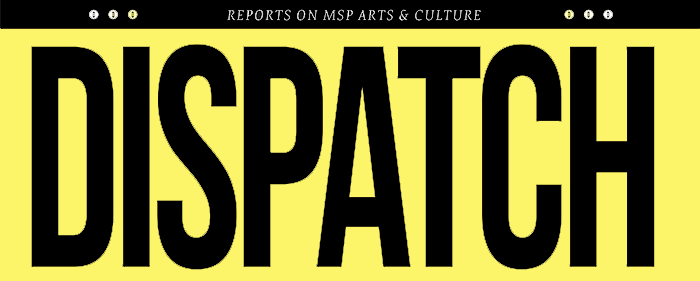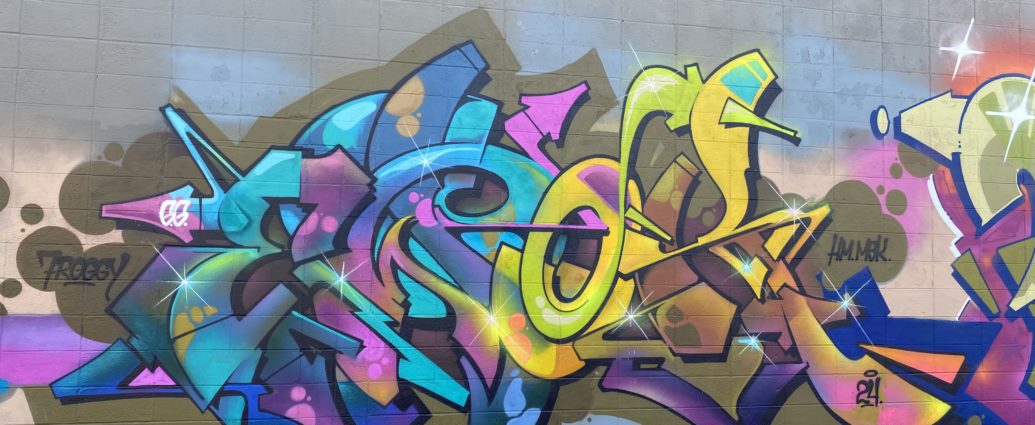What we talk about when we talk about public art with curator Joe Ellis.
WORDS BY CHLOE GALLAGHER
“I won’t stop painting ’til l the world looks the way it should” —Typical Cats
“It jumped off the walls,” Joe Ellis recalled over coffee at Wuolett Bakery, describing his first encounters with graffiti art. “I was just a little kid, I didn’t know anything. I was just walking around and it spoke to me directly.”
Ellis hails from South Minneapolis —soft spoken, fervent, and potently articulate. A savvy arts professional who spent 16 years working in galleries in NYC, he’s in his second year as curator of the LynLake Street Art Series. On the morning of our meeting, he was deep into the 11th hour of exhibition preparation. Despite his limited time, he was generous with his thoughts and observations. We talked about hip-hop, railyards, Gothic Futurism, Basquiat, and the past and future of the Greenway. He has a craftsman’s ability to spin my diversionary remarks into precise observations about the exhibition, doggedly weaving various conversational threads into the curatorial tapestry he’s composing.
This year will be the sixth iteration of the popular street art showcase, and it yet again comes through with an impressive lineup of artists from around the world: More than 30 new murals will go up along the LynLake corridor, showcasing the talents of more than 50 creators. Ellis is unsparing in his praise of the artists involved in the show, as well as mentors who helped him along the way, such as Morgan Luzier, co-chair of the LynLake Business Association, and Peyton Scott Russel, his former teacher and the co-founder of SPRAYfinger.
A direct collaborator and sponsor of the event, SPRAYfinger promotes “graffiti as a teachable fine art by collaborating with schools, teachers, and artists on curriculum designs, outlines, and lesson plans.” Russell has been an arts educator for more than 30 years, and discovered his passion for graffiti art after seeing the iconic 1984 film Style Wars. Teaching people, both young and old, about graffiti and contextualizing it within the fine art domain has the effect of both destigmatizing an often maligned medium, and harnessing the energy of artists whose passion can land them in hot water without legitimate platforms for creative expression.
“I got into trouble doing graffiti as a kid in high school,” Ellis says. “I would get arrested, our house would get raided. There were consequences for it. My mom had a [metaphorical] heart attack. She pushed me, and the way she pushed me was into the Walker Art Center to take classes about Elsworth Kelly. She tried to channel it into a new direction.”
Studying and creating in spaces of quote-unquote sanctified art didn’t turn Ellis away from graffiti, though: It merely broadened his palette. He took classes at Juxtaposition Arts in North Minneapolis and did post-secondary courses at the Minneapolis College of Art and Design. He spent long afternoons wandering the halls of the MIA, admiring works by artists such as Grace Hartigan and Frank Stella. After high school, Ellis moved to NYC and studied art history at The School of the Visual Arts.
“I went to New York, fell in love with art history. Art history spoke to me, but it came to me through graffiti,” Ellis explained.
If you want to take the scenic route, the origins of graffiti can be traced back to the earliest sites of human creation, from Paleolithic cave painting to the Roman empire. If that feels like a stretch, as cave walls might as well have been canvas at the time, bear in mind that the oldest piece of graffiti recorded in Pompeii, from 78 BC, translates to “Gaius was here.” That’s a tag. An illicit tag. Someone making themselves known, claiming space, and making a mark on history. “Really this is the conversation of art history, this is the actual, living moment of art history, as it’s happening,” Ellis says. “It’s a greater connection, and a conduit to art that came before.”
We discuss briefly the so-called Golden Age of Graffiti, which started in the late ’60s and early ’70s, building steam and coalescing into the artistic juggernaut that was NYC commuter train graffiti. “There’s this beautiful moment, it’s building and building, and just explodes,” he says. “Painting decided it was going to jump out of galleries and museums and onto trains.”
The transgressive nature of graffiti art is both one of its alluring qualities, and one of the aspects that consistently pulls its chair away from the table where the art historical canon is seated. The demographics of who paints graffiti are diverse, but they generally share a common feature: They are people whose voices are rarely heard, who do not see themselves represented in the art or audience of major institutions, and who do not have a straight path to success in the world, creative or not. Graffiti artists are described variously as “thugs,” “criminals,” or “vandals.” Many critics cannot see past the real or perceived trespass of unsanctioned public art enough to even consider its potential aesthetic, political, or intellectual merit.
“There’s a lot to this statement, but I think graffiti, in essence, is a trauma response. It’s pure creative energy that we’re channeling, that’s coming out of us,” Ellis clarifies. “It’s a trauma response that needs a creative outlet that then has a space for expression in the city that caused [it]; the spaces, environments, and systems that caused those traumas.”
In 1979, musician-scholar-graffiti writer Rammellzee wrote his momentous manifesto on what he called “Gothic Futurism.” Describing graffiti artworks as “instruments of symbolic war,” he outlines a complex lexicon of subverted symbology, issuing marching orders to a ragtag army of those in pursuit of liberation from prescribed definitions set by oppressive forces. Substance isn’t the only thing Rammellzee puts on the menu: He also underscores the importance of style as a way to dazzle, confuse, dominate, and overcome.
“The essence of Rammellezee’s manifesto is that language is a form of violence,” Ellis says. “There’s violence in the words and language we use between each other. A graffiti writer is taking the language, these letters, from the constraints of language, freeing them, liberating them, and then armoring themselves with them to do battle with systems of oppression. That’s fucking brilliant.”
Ellis returned to Minneapolis in 2016. Last year, he was asked to join the LynLake SAS team as a curator, and he pulled off three ambitious projects: Along with the outdoor graffiti wall he curated at Cub Foods East, he organized an exhibition of protest photography by local artist KingDemetirius Pendleton and a group show of drawings from the Black Books (a type of sketchbook/journal/proving ground for graf writers) of artists participating in the larger series.
“The show this year is about honoring the earlier generation of graffiti artists, who really blazed the trail for all of us,” he says of this year’s exhibition.
Recently, while spending time with his father, brother, and son, Ellis had an epiphany that shaped the narrative of this year’s event. He decided to trace the generational and stylistic legacies of Twin Cities graffiti, showcasing artists from at least three distinct eras of writers in the area. Along with the dozens of walls that will be painted between July 14 and 16, there will be a special exhibition, held at the MoZaic Building, titled Paintings. The show will include a multitude of forms, from canvases and limited prints to found objects and light sculptures, and run from July 14 through August 11. Artists showcased in Paintings will also paint a wall on the West side of Cub Foods in Uptown, in chronological order of appearance on the scene. The exhibition is a graffiti family tree of sorts.
At the roots are Daesk One, aka Peyton Scott Russell, and Emer AKB, who attended South High School, a mecca of local graffiti development. Ellis describes Emer as a “master teacher.” You might also know him as I Self Devine, a veteran of the local hip-hop scene and Rhymesayers. Building up the trunk are local legends Yen34 and Ewok, who Ellis cites as his “all-time graffiti heroes.” Ewok is originally from Wisconsin, but moved to Minnesota in the late ’90s, and Ellis describes him as “the Picasso of South Minneapolis.” Yen34 is from St. Paul and a masterful draftsman who’s black book Bic drawings Ellis says would “make you embarrassed to ever call yourself an artist.” Wes Winship, aka Kahn HM, co-founded the publication Life Sucks Die, a bible of Minneapolis graffiti, and later went on to co-found Burlesque of North America, a local graphic design and print shop. Shock UC MSK met Ellis at Juxtaposition decades ago, and represents the leafing buds of new style evolutions in the local scene, described by the curator as a “Post-Modern Minneapolis graffiti artist.” Rime MSK isn’t local, but despite the regional focus of parts of this year’s festivities, the project is also about bringing visionary artists to share their talent with the community.
Just over a mile from the epicenter of the LynLake SAS is the Minneapolis Sculpture Garden. It’s maintained by the municipal Parks & Rec department, free and open to the public, but its institutional association with the Walker lends it more rarified air. Among the more recognizable works of public art, like Claes Oldenberg’s “Spoonbridge and Cherry,” are a series of stone benches emblazoned with discursive statements by artist Jenny Holzer. Her text-based works often transcended gallery walls, and she was part of the Times Square Show in 1980 that launched the careers of Jean Michel Basquiat and Keith Haring, two of the most commercially successful graffiti artists of the Golden Era. An iconic photo of famed graffiti doyenne Lady Pink wearing one of her Truism T-Shirt Series works reading “Abuse of Power Comes As No Surprise” recently went viral in relation to the #metoo movement. She was a keen observer of the politics of the artworld. My favorite of these works at the Sculpture Garden, from 1989’s The Living Series, seems apropos for this story. It reads:
“BY YOUR RESPONSE TO DANGER IT IS EASY TO TELL HOW YOU HAVE LIVED AND WHAT HAS BEEN DONE TO YOU. YOU SHOW WHETHER YOU WANT TO STAY ALIVE, WHETHER YOU THINK YOU DESERVE TO, AND WHETHER YOU BELIEVE IT’S ANY GOOD TO ACT.”

